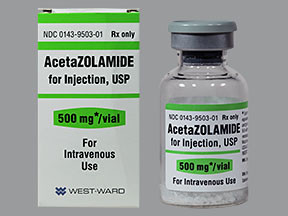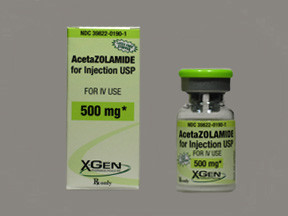ACETAZOLAMIDE - INJECTION
PHONETIC PRONUNCIATION: (a-SEET-a-ZOE-la-mide)
GENERIC NAME(S): acetazolamide sodium
Uses
USES: This medication is used with other medications to treat high pressure inside the eye due to certain types of glaucoma. Acetazolamide belongs to a class of drugs known as carbonic anhydrase inhibitors. It works by decreasing the production of fluid inside the eye. It is also used to decrease a buildup of body fluids (edema) caused by heart failure or certain medications. Acetazolamide can work less well over time, so it is usually used only for a short period. It has also been used with other medications to treat certain types of seizures (petit mal and unlocalized seizures).
How to use ACETAZOLAMIDE - INJECTION
HOW TO USE: This medication is given by injection into a vein by a health care professional. It is given as directed by your doctor, usually 1 to 4 times daily. If you use this drug too close to bedtime, you may need to wake up to urinate. It is best to use this medication at least 4 hours before your bedtime. The dosage is based on your medical condition and response to treatment. Drink plenty of fluids unless otherwise directed by your doctor. Use this medication regularly to get the most benefit from it. To help you remember, use it at the same time(s) each day. Do not increase your dose or use this drug more often or for longer than prescribed. Your condition will not improve any faster, and your risk of side effects will increase. Tell your doctor if your condition lasts or gets worse.
Side Effects
Precautions
Interactions
Overdose
Images
Reviews
Faq for ACETAZOLAMIDE - INJECTION
AcetaZOLAMIDE injection is used to treat various medical conditions such as glaucoma, altitude sickness, and edema.
AcetaZOLAMIDE injection works by reducing the production of fluid in the eye, which helps lower intraocular pressure in glaucoma. It also helps regulate fluid balance in the body, reducing symptoms of edema and altitude sickness.
Common side effects of acetaZOLAMIDE injection may include dizziness, nausea, vomiting, increased urination, and a metallic taste in the mouth. These side effects are usually mild and temporary.
AcetaZOLAMIDE injection is typically given by a healthcare professional in a hospital or clinic setting. It is usually injected into a vein, but can also be injected into a muscle.
AcetaZOLAMide injection should not be used by individuals who are allergic to the medication or any of its ingredients. It should also be avoided by patients with certain medical conditions such as liver or kidney disease, adrenal gland problems, or electrolyte imbalances.
The use of acetaZOLAMide injection during pregnancy or breastfeeding should be discussed with a healthcare provider. It may be necessary to weigh the potential benefits against any potential risks to the developing fetus or infant.
If you miss a dose of acetaZOLAMide injection, contact your healthcare provider for instructions. It is important not to double the dose to catch up, as it may increase the risk of side effects.
AcetaZOLAMide injection may interact with certain medications, including other diuretics, anticonvulsants, and blood thinners. It is important to inform your healthcare provider about all the medications you are taking to avoid potential drug interactions.
The onset of action of acetaZOLAMide injection varies depending on the condition being treated. In some cases, it may start working within a few hours, while in others, it may take several days to see the full effects.
Disclaimer
IMPORTANT: HOW TO USE THIS INFORMATION: This is a summary and does NOT have all possible information about this product. This information does not assure that this product is safe, effective, or appropriate for you. This information is not individual medical advice and does not substitute for the advice of your health care professional. Always ask your health care professional for complete information about this product and your specific health needs.



No Reviews Yet